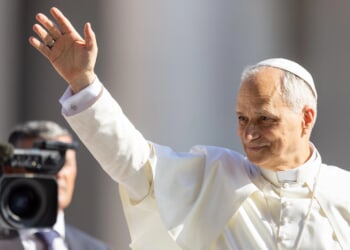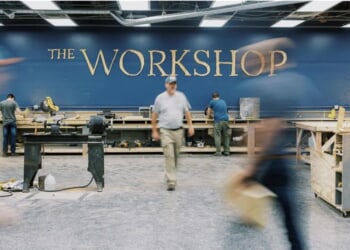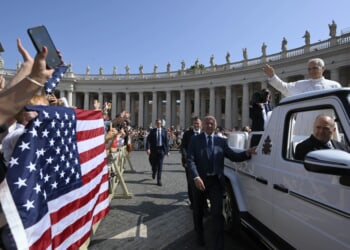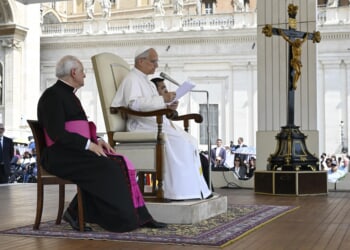Vatican City, Jun 30, 2025 /
07:00 am
After a decade of painstaking restoration, the imposing Hall of Constantine in the Vatican’s Apostolic Palace, which houses Raphael’s masterpiece depicting Constantine’s victory over Maxentius at the Milvian Bridge, has been returned to its original splendor.
This space, the largest of the well-known Raphael Rooms, was partially closed to the public in 2015 due to delicate conservation work that ultimately culminated in a result described as “exemplary” by Vatican Museums.
“In a way, we have rewritten the history of art,” explained Barbara Jatta, director of the Vatican Museums, during a June 26 presentation to the press held at the Vatican Museums. She was joined by Fabrizio Biferali, supervisor of the art department for the 15th and 16th centuries; Fabio Piacentini and Francesca Persegati from the Painting and Wooden Materials Restoration Laboratory; and Fabio Morresi, head of the Scientific Research Office, who emphasized the scientific, technical, and symbolic value of a project that has brought to light revolutionary discoveries about the techniques and methods of the Renaissance master.
The restoration, which began in March 2015 and was completed in December 2024, has not only restored the brilliance of the frescoes that Pope Leo X commissioned Raphael Sanzio (1483–1520) to paint but also revealed important technical and artistic innovations concerning one of the great workshops of the Renaissance.
The process, carried out in eight phases, began with the wall of “The Vision of the Cross” and concluded with the vault decorated by Tommaso Laureti. The planning of the scaffolding followed the same sequence as the original execution of the paintings, allowing for a diachronic interpretation of the evolution of the complex.
Raphael and oil painting: A revolutionary discovery
One of the project’s greatest revelations has been the confirmation that two female figures — Comitas and Iustitia — were executed directly by Raphael in oil, an extremely unusual technique for murals at the time. “We knew from sources that Raphael did experiments, but we didn’t know which ones,” Jatta explained.
Thanks to scientific analyses such as infrared refractography at 1,900 nanometers, false-color ultraviolet light, and chemical studies of the paint layer, a special preparation of rosin, a natural resin heated and applied to the wall, was identified. This technique would have allowed Raphael to make retouchings and achieve a visual unity not possible with traditional fresco.
“This was his last major decorative undertaking and represents a true technical revolution,” said Piacentini, who was responsible for the restoration project from the outset. The presence of nails in the wall indicates that Raphael intended to paint the entire room in oils, a project interrupted by his untimely death in 1520 when he was only 37 years old.
The work was continued by his disciples Giulio Romano and Giovanni Francesco Penni, who painted the remaining fresco scenes. “It was a work of years, comparable to that of a team from the Renaissance: Restorers, chemists, engineers, and heritage experts worked as if in a true workshop,” emphasized Jatta, who also praised Persegati’s coordination in the Vatican’s oldest laboratory.
A 16th-century pictorial palimpsest
The Hall of Constantine, designed for official receptions and named after the emperor who granted freedom of worship and thus brought Christianity out from the underground with the Edict of Milan (A.D. 313), constitutes a kind of artistic palimpsest (an ancient tablet on which writing could be erased and rewritten). It was decorated over more than 60 years under five pontificates — from Leo X to Sixtus V — with work done by different artists and workshops, making it an exceptional synthesis of 16th-century Roman painting.
Its walls depict four key episodes: “The Vision of the Cross,” “The Battle of the Milvian Bridge,” “The Baptism of Constantine,” and “The Donation of Rome.” All of them symbolize the transition from pagan Rome to Christian Rome and constitute, according to Jatta, “the most politically and programmatically important room in the complex.”
A vault that deceives the eye
Another highlight of the project is the restoration of the vault painted with an allegorical scene of the triumph of Christianity over paganism by Tommaso Laureti during the pontificate of Sixtus V. Among the discoveries is the visual illusion of a carpet in the center of the vault, simulating a sumptuous fabric painted directly onto the ceiling’s surface.
Replacing the old wooden ceiling, Laureti created an impressive marvel of illusionistic perspective with plays of light and shadow that can now be admired in all its beauty after having been cleaned.
(Story continues below)
Subscribe to our daily newsletter
An exemplary restoration, a model for the future
The project was made possible thanks to the patronage of the New York chapter of the Patrons of the Arts in the Vatican Museums and the Carlson Foundation, along with the institutional support of the presidency of the Governorate of Vatican City State and its general secretariat.
The work was fully documented through laser scans and 3D models, becoming an international reference for the restoration of large mural decorations. Furthermore, a detailed study of the plaster layers made it possible to reconstruct the exact chronology of the steps in making the frescoes.
Morresi of the Vatican Museums’ Scientific Research Office summed up the spirit of the project with words that evoke both science and poetry: “The most exciting thing is how artists of the past managed to transform matter and chemistry into something so marvelous.”
The reopening of the Hall of Constantine not only restores a key space in the Vatican museum but also returns to humanity a Renaissance masterpiece, a testament to Raphael’s genius.
This story was first published by ACI Prensa, CNA’s Spanish-language news partner. It has been translated and adapted by CNA.


















